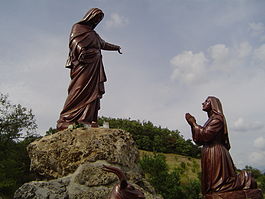 Statues depicting the apparition of Mary to Benoite Rencurel at La Laus, France.
Statues depicting the apparition of Mary to Benoite Rencurel at La Laus, France. One of the most fervent forms of devotion in Roman Catholicism is to the visions of Mary, commonly called “apparitions.” For many centuries, in many locations around the world, Mary is alleged to have appeared to visionaries of the Roman Catholic Church. These visionaries typically report conversations with Mary, and the apparition of Mary has many times delivered messages that have been documented through the official channels of the Roman Catholic Church. There have been many hundreds of alleged apparitions throughout history, but only a few have been approved officially by the Roman Catholic Church. These few are considered to be actual bodily appearances of Mary, and therefore “worthy of belief.” Among them are the Apparitions of Mary at Guadalupe, Mexico (1531); Paris, France (1830); La Salette, France (1846); Lourdes, France (1858); and Fatima, Portugal (1917).
The approval process for an alleged apparition can take many years, and it is rare for one to be elevated formally to the same level as those listed above. When that approval becomes official, it provides a tremendous amount of insight into the visions of Mary themselves because interviews with the visionaries are meticulously inspected, and the vision’s messages and teachings are rigorously documented through the approval process. It also provides tremendous insight into the Roman Catholic Church, because the teachings of approved apparitions are consistent with Roman Catholic teaching—otherwise they would not have been approved.
The recent approval of the Apparitions of Mary in La Laus, France is significant for this reason. The vision of Mary in La Laus appeared to Benoite Rencurel in 1664 and continued for 54 years. Early in her encounters, Benoite was resisted by the church hierarchy and was tempted to give up. The vision encouraged her to press on:
“No, My daughter, you must not run away. … don’t be afraid. Tell the Vicar General that he can very well make God come down from Heaven by the power he received when he became a priest, but he has no commands to give the Mother of God.
There are many other teachings to evaluate from La Laus, but this one is highlighted because it shows Christ subjected as a prisoner and a servant to the Roman Catholic priest, but Mary free of any such encumbrances. When Benoite conveyed this message to the Vicar General, the meaning of the message was quite clear:
“Sire, although you command God each morning and make Him come down to the altar by the power you received when you became a priest, you have no commands to give His holy Mother, who does as She pleases here.”
That message was the turning point, and the Vicar General allowed Benoite to continue receiving visits from the apparition. On May 5, 2008, more than three hundred years after the visions began, the apparitions of Mary at La Laus were approved as worthy of devotion.
Not surprisingly, this depiction of Mary as equal, or superior, to Christ is consistent in approved apparitions. The Fatima apparition taught that Jesus wants Mary to be honored throughout the world:
“Jesus wishes to make use of you to have me acknowledged and loved. He wishes to establish in the world the devotion to My Immaculate Heart.”
The La Salette apparition of Mary taught that Jesus was angry because people were not setting aside the Sabbath day to honor Mary:
“I gave you six days for working. The seventh I have reserved for myself. But no one will give it to me. This is what causes the weight of my Son’s arm to be so crushing.”
Two things are abundantly clear from La Laus and other approved apparitions: 1) the visions of Mary eagerly desire to be elevated to the level of Jesus Christ and higher, and 2) the Roman Catholic Church is formally comfortable with that elevation. Listen to Father Eymard explain how the three Persons of the Trinity waited to discover what Mary’s answer would be to the Angel Gabriel at the annunciation:
“The angel is the first to salute. He is, indeed, the less worthy of the two. Mary is sovereign here, and since the Three Divine Persons are awaiting an answer, she holds in her hands the fate of the world. Ah, how powerful is that lowly maiden!” (Eymard, Month of Our Lady of the Blessed Sacrament, trans. from the Sixth French Edition, 1903, p. 55).
Fr. Eymard is one of the most famous proponents of the La Laus apparitions, and it is clear that he swallowed their teachings whole. We will explore these and other apparitions of Mary later, but the formal approval of an apparition is worthy of special notice.
The Mary of the visions, of course, is not the Mary of the Bible. For more information on the history of the apparitions of Mary, and their unbiblical messages, you can see my book, Quite Contrary: A Biblical Reconsideration of the Apparitions of Mary here.
